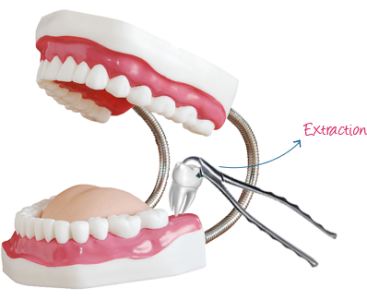Dental Extractions
Dental Extractions
A dental extraction is the removal of teethfrom the dental alveolus (socket) in the alveolar bone. Extractions are performed for a wide variety of reasons, but most commonly to remove teeth which have become unrestorable through tooth decay, periodontal disease or dental trauma, especially when they are associated with toothache. Sometimes wisdom teeth are impacted (stuck and unable to grow normally into the mouth) and may cause recurrent infections of the gum (pericoronitis). In orthodontics if the teeth are crowded, sound teeth may be extracted (often bicuspids) to create space so the rest of the teeth can be straightened.
Some teeth are more difficult to remove for several reasons, especially related to the tooth’s position, the shape of the tooth roots and the integrity of the tooth. Dental phobia is an issue for some individuals, and tooth extraction tends to be feared more than other dental treatments like fillings. If a tooth is buried in the bone, a surgical or trans alveolar approach may be required, which involves cutting the gum away and removal of the bone which is holding the tooth in with a surgical drill. After the tooth is removed, stitches are used to replace the gum into the normal position.

Causes for Dental Extractions:
- Advanced periodontal disease. (inflammation of gums, bone and surrounding tissues that support teeth).
- Abscess formation.
- Excessive caries.
- Failed endodontic treatment.
- Extraction also may be part of an orthodontic or prosthodontic treatment plan.
- Retained roots also may require surgical removal.
- Third molar (wisdom tooth) impaction.
Benefits of Dental Extractions:
- Extraction helps you relieveyour current symptoms and/or permits you to continue with any additional treatment.
- Prevents dental abscess (Pus) formation in a badly decayed or infected tooth.
- Impacted wisdom teeth can lead to other conditions like – Pericoronitis, Cavities, Resorption of teeth, Gum Problems and in rare cases cysts or tumors.

